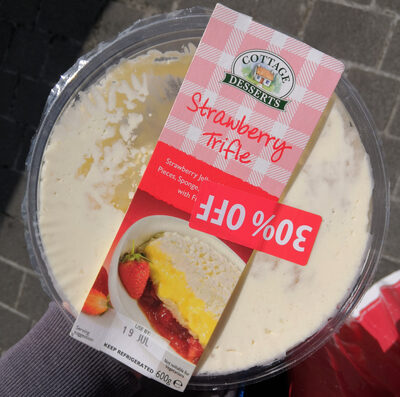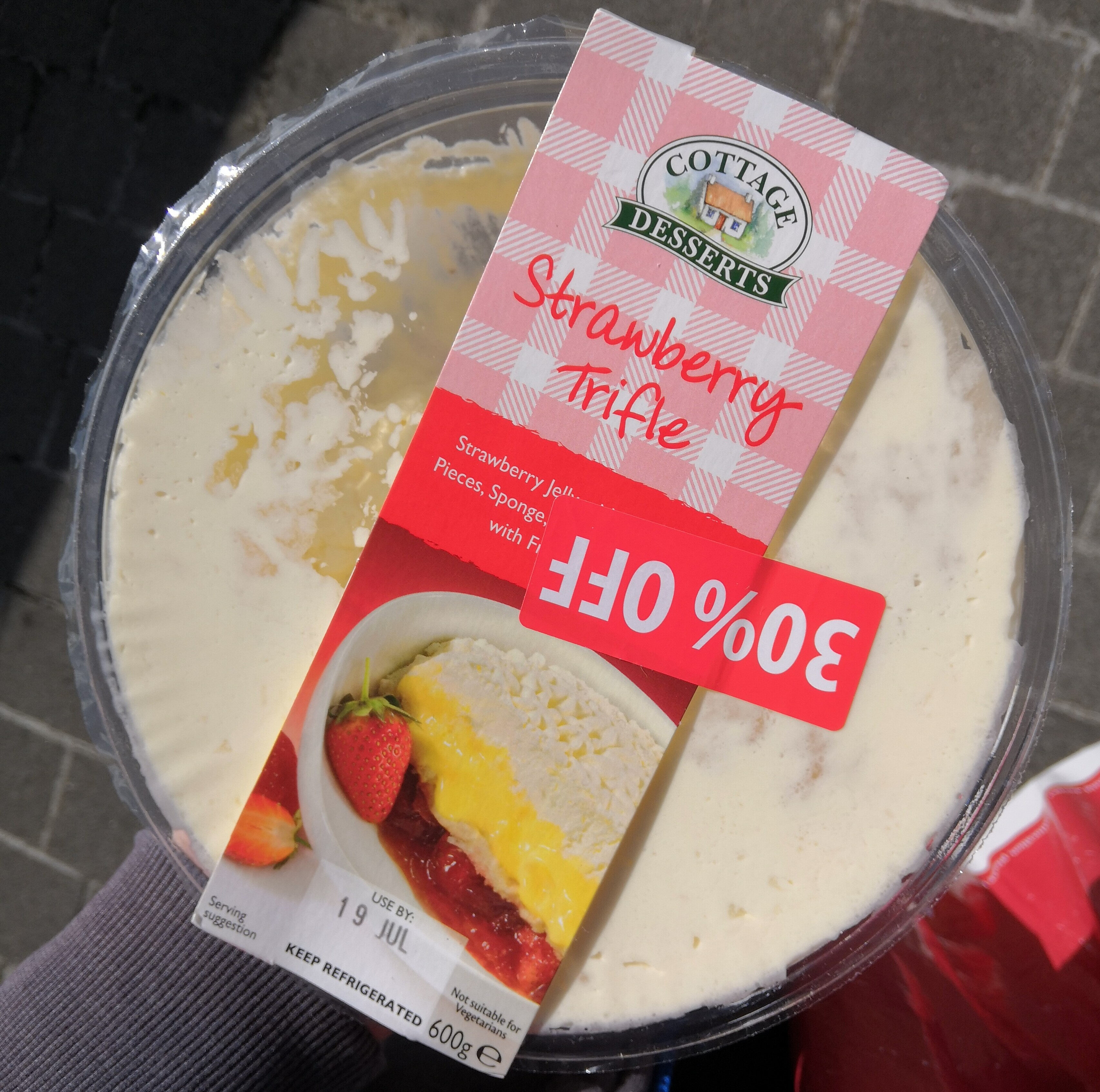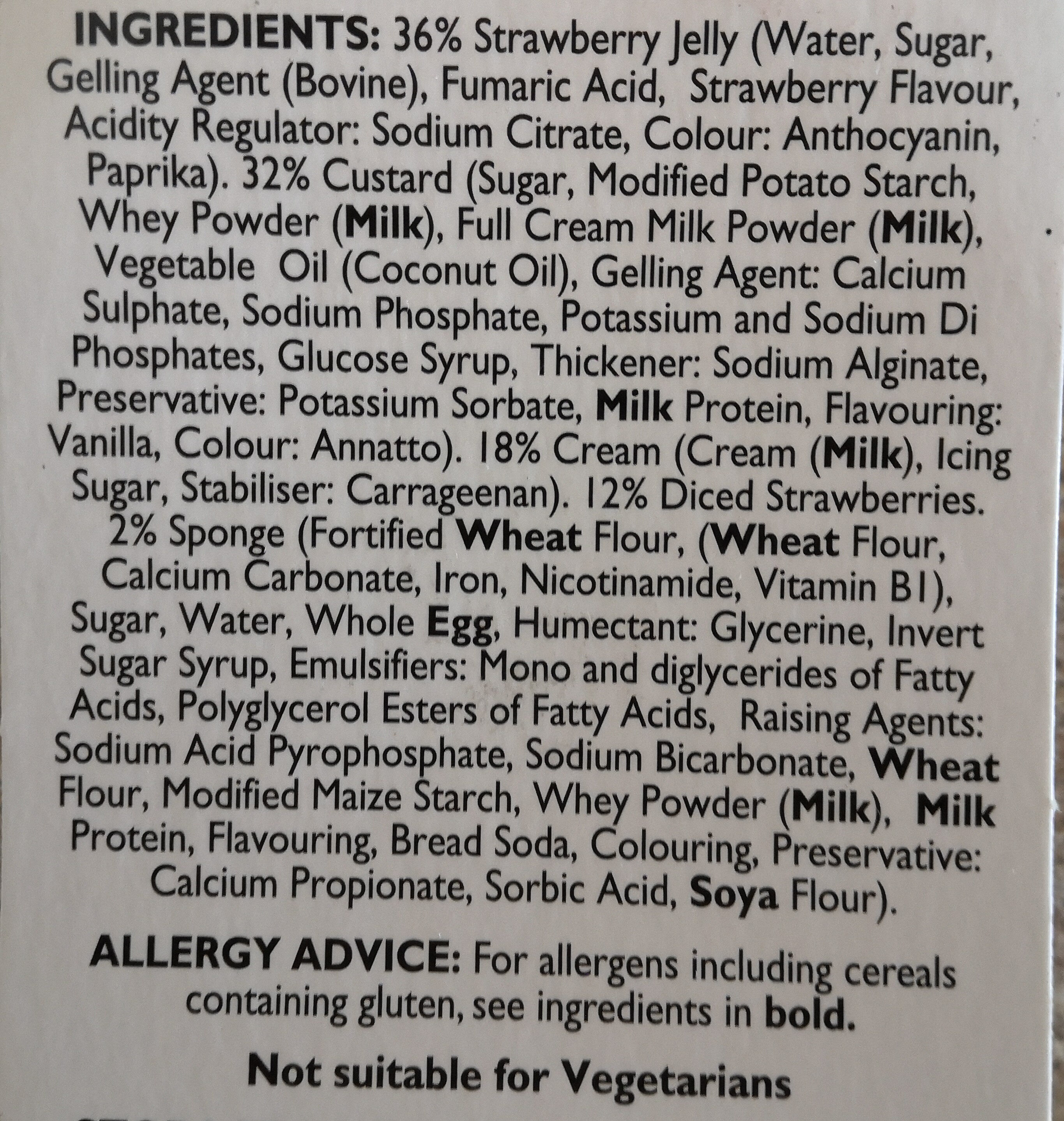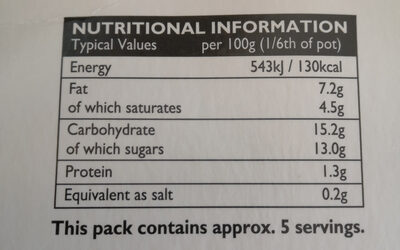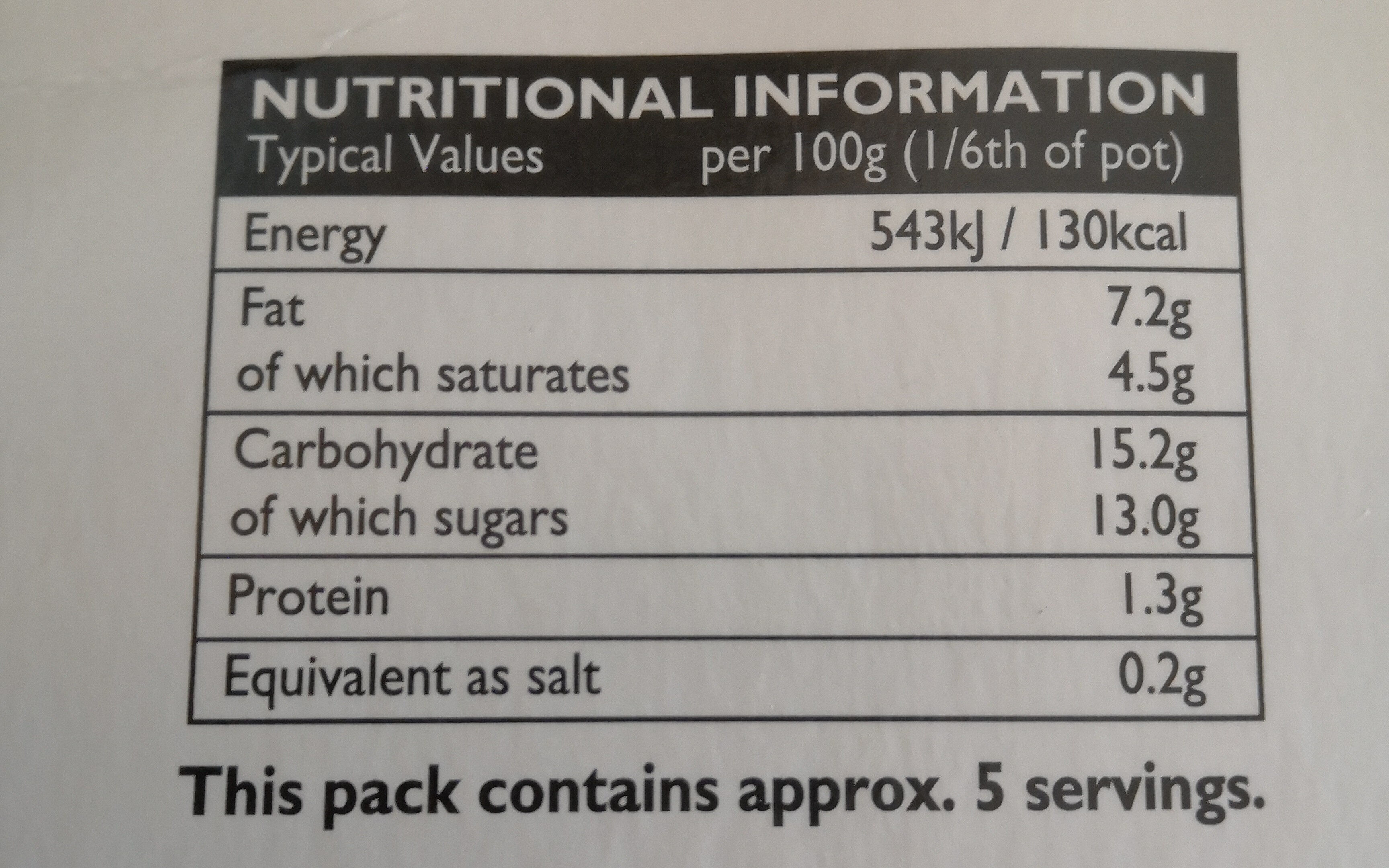Help us make food transparency the norm!
As a non-profit organization, we depend on your donations to continue informing consumers around the world about what they eat.
The food revolution starts with you!
Strawberry Trifle - Cottage Desserts - 600 g
Strawberry Trifle - Cottage Desserts - 600 g
This product page is not complete. You can help to complete it by editing it and adding more data from the photos we have, or by taking more photos using the app for Android or iPhone/iPad. Thank you!
×
Barcode: 5020590709140 (EAN / EAN-13)
Quantity: 600 g
Packaging: Plastic
Brands: Cottage Desserts
Categories: Snacks, Desserts, Sweet snacks, Biscuits and cakes, Cakes, Fruit cakes, Trifles
Labels, certifications, awards: Non-vegetarian
Stores: Aldi
Matching with your preferences
Health
Ingredients
-
70 ingredients
36% Strawberry Jelly (Water, Sugar, Gelling Agent (Bovine), Fumaric Acid, Strawberry Flavour, Acidity Regulator: Sodium Citrate, Colour: Anthocyanin, Paprika). 32% Custard (Sugar, Modified Potato Starch, Whey Powder (Milk), Full Cream Milk Powder (Milk), Vegetable Oil (Coconut Oil), Gelling Agent: Calcium Sulphate, Sodium Phosphate, Potassium and Sodium Di Phosphates, Glucose Syrup, Thickener: Sodium Alginate, Preservative: Potassium Sorbate, Milk Protein, Flavouring: Vanilla, Colour: Annatto). 18% Cream (Cream (Milk), Icing Sugar, Stabiliser: Carrageenan). 12% Diced Strawberries. 2% Sponge (Fortified Wheat Flour, (Wheat Flour, Calcium Carbonate, Iron, Nicotinamide, Vitamin BI), Sugar, Water, Whole Egg, Humectant: Glycerine, Invert Sugar Syrup, Emulsifiers: Mono and diglycerides of Fatty Acids, Polyglycerol Esters of Fatty Acids, Raising Agents: Sodium Acid Pyrophosphate, Sodium Bicarbonate, Wheat Flour, Modified Maize Štarch, Whey Powder (Milk), Milk Protein, Flavouring, Bread Soda, Colouring, Preservative: Calcium Propionate, Sorbic Acid, Soya Flour). ALLERGY ADVICE: For allergens including cereals containing gluten, see ingredients in bold. Not suitable for VegetariansAllergens: Eggs, Gluten, Milk, Soybeans
Food processing
-
Ultra processed foods
Elements that indicate the product is in the 4 - Ultra processed food and drink products group:
- Additive: E160b - Annatto
- Additive: E163 - Anthocyanins
- Additive: E401 - Sodium alginate
- Additive: E407 - Carrageenan
- Additive: E422 - Glycerol
- Additive: E450 - Diphosphates
- Additive: E471 - Mono- and diglycerides of fatty acids
- Additive: E475 - Polyglycerol esters of fatty acids
- Ingredient: Colour
- Ingredient: Emulsifier
- Ingredient: Flavouring
- Ingredient: Gelling agent
- Ingredient: Glucose
- Ingredient: Glucose syrup
- Ingredient: Humectant
- Ingredient: Invert sugar
- Ingredient: Milk proteins
- Ingredient: Thickener
- Ingredient: Whey
Food products are classified into 4 groups according to their degree of processing:
- Unprocessed or minimally processed foods
- Processed culinary ingredients
- Processed foods
- Ultra processed foods
The determination of the group is based on the category of the product and on the ingredients it contains.
Additives
-
E163 - Anthocyanins
Anthocyanin: Anthocyanins -also anthocyans; from Greek: ἄνθος -anthos- "flower" and κυάνεος/κυανοῦς kyaneos/kyanous "dark blue"- are water-soluble vacuolar pigments that, depending on their pH, may appear red, purple, or blue. Food plants rich in anthocyanins include the blueberry, raspberry, black rice, and black soybean, among many others that are red, blue, purple, or black. Some of the colors of autumn leaves are derived from anthocyanins.Anthocyanins belong to a parent class of molecules called flavonoids synthesized via the phenylpropanoid pathway. They occur in all tissues of higher plants, including leaves, stems, roots, flowers, and fruits. Anthocyanins are derived from anthocyanidins by adding sugars. They are odorless and moderately astringent. Although approved to color foods and beverages in the European Union, anthocyanins are not approved for use as a food additive because they have not been verified as safe when used as food or supplement ingredients. There is no conclusive evidence anthocyanins have any effect on human biology or diseases.Source: Wikipedia
-
E200 - Sorbic acid
Sorbic acid: Sorbic acid, or 2‚4-hexadienoic acid, is a natural organic compound used as a food preservative. It has the chemical formula CH3-CH-4CO2H. It is a colourless solid that is slightly soluble in water and sublimes readily. It was first isolated from the unripe berries of the Sorbus aucuparia -rowan tree-, hence its name.Source: Wikipedia
-
E202 - Potassium sorbate
Potassium sorbate (E202) is a synthetic food preservative commonly used to extend the shelf life of various food products.
It works by inhibiting the growth of molds, yeast, and some bacteria, preventing spoilage. When added to foods, it helps maintain their freshness and quality.
Some studies have shown that when combined with nitrites, potassium sorbate have genotoxic activity in vitro. However, potassium sorbate is generally recognized as safe (GRAS) by regulatory authorities.
-
E282 - Calcium propionate
Calcium propanoate: Calcium propanoate or calcium propionate has the formula Ca-C2H5COO-2. It is the calcium salt of propanoic acid.Source: Wikipedia
-
E297 - Fumaric acid
Fumaric acid: Fumaric acid or trans-butenedioic acid is the chemical compound with the formula HO2CCH=CHCO2H. It is produced in eukaryotic organisms from succinate in complex 2 of the electron transport chain via the enzyme succinate dehydrogenase. It is one of two isomeric unsaturated dicarboxylic acids, the other being maleic acid. In fumaric acid the carboxylic acid groups are trans -E- and in maleic acid they are cis -Z-. Fumaric acid has a fruit-like taste. The salts and esters are known as fumarates. Fumarate can also refer to the C4H2O2−4 ion -in solution-.Source: Wikipedia
-
E331 - Sodium citrates
Sodium citrate: Sodium citrate may refer to any of the sodium salts of citrate -though most commonly the third-: Monosodium citrate Disodium citrate Trisodium citrateThe three forms of the salt are collectively known by the E number E331. Sodium citrates are used as acidity regulators in food and drinks, and also as emulsifiers for oils. They enable cheeses to melt without becoming greasy.Source: Wikipedia
-
E407 - Carrageenan
Carrageenan (E407), derived from red seaweed, is widely employed in the food industry as a gelling, thickening, and stabilizing agent, notably in dairy and meat products.
It can exist in various forms, each imparting distinct textural properties to food.
However, its degraded form, often referred to as poligeenan, has raised health concerns due to its potential inflammatory effects and its classification as a possible human carcinogen (Group 2B) by the International Agency for Research on Cancer (IARC).
Nevertheless, food-grade carrageenan has been deemed safe by various regulatory bodies when consumed in amounts typically found in food.
-
E422 - Glycerol
Glycerol: Glycerol -; also called glycerine or glycerin; see spelling differences- is a simple polyol compound. It is a colorless, odorless, viscous liquid that is sweet-tasting and non-toxic. The glycerol backbone is found in all lipids known as triglycerides. It is widely used in the food industry as a sweetener and humectant and in pharmaceutical formulations. Glycerol has three hydroxyl groups that are responsible for its solubility in water and its hygroscopic nature.Source: Wikipedia
-
E450 - Diphosphates
Diphosphates (E450) are food additives often utilized to modify the texture of products, acting as leavening agents in baking and preventing the coagulation of canned food.
These salts can stabilize whipped cream and are also found in powdered products to maintain their flow properties. They are commonly present in baked goods, processed meats, and soft drinks.
Derived from phosphoric acid, they're part of our daily phosphate intake, which often surpasses recommended levels due to the prevalence of phosphates in processed foods and drinks.
Excessive phosphate consumption is linked to health issues, such as impaired kidney function and weakened bone health. Though diphosphates are generally regarded as safe when consumed within established acceptable daily intakes, it's imperative to monitor overall phosphate consumption to maintain optimal health.
-
E471 - Mono- and diglycerides of fatty acids
Mono- and diglycerides of fatty acids (E471), are food additives commonly used as emulsifiers in various processed foods.
These compounds consist of glycerol molecules linked to one or two fatty acid chains, which help stabilize and blend water and oil-based ingredients. E471 enhances the texture and shelf life of products like margarine, baked goods, and ice cream, ensuring a smooth and consistent texture.
It is generally considered safe for consumption within established regulatory limits.
-
E500 - Sodium carbonates
Sodium carbonates (E500) are compounds commonly used in food preparation as leavening agents, helping baked goods rise by releasing carbon dioxide when they interact with acids.
Often found in baking soda, they regulate the pH of food, preventing it from becoming too acidic or too alkaline. In the culinary world, sodium carbonates can also enhance the texture and structure of foods, such as noodles, by modifying the gluten network.
Generally recognized as safe, sodium carbonates are non-toxic when consumed in typical amounts found in food.
-
E500ii - Sodium hydrogen carbonate
Sodium hydrogen carbonate, also known as E500ii, is a food additive commonly used as a leavening agent.
When added to recipes, it releases carbon dioxide gas upon exposure to heat or acids, causing dough to rise and resulting in a light, fluffy texture in baked goods.
It is generally recognized as safe (GRAS) by regulatory authorities when used in appropriate quantities and poses no significant health risks when consumed in typical food applications.
Ingredients analysis
-
May contain palm oil
Ingredients that may contain palm oil: E471
-
Non-vegan
Non-vegan ingredients: Whey powder, Whole milk powder, Milk proteins, Cream, Cream, Whole egg, Whey powder, Milk proteinsSome ingredients could not be recognized.
We need your help!
You can help us recognize more ingredients and better analyze the list of ingredients for this product and others:
- Edit this product page to correct spelling mistakes in the ingredients list, and/or to remove ingredients in other languages and sentences that are not related to the ingredients.
- Add new entries, synonyms or translations to our multilingual lists of ingredients, ingredient processing methods, and labels.
If you would like to help, join the #ingredients channel on our Slack discussion space and/or learn about ingredients analysis on our wiki. Thank you!
-
Non-vegetarian
Some ingredients could not be recognized.
We need your help!
You can help us recognize more ingredients and better analyze the list of ingredients for this product and others:
- Edit this product page to correct spelling mistakes in the ingredients list, and/or to remove ingredients in other languages and sentences that are not related to the ingredients.
- Add new entries, synonyms or translations to our multilingual lists of ingredients, ingredient processing methods, and labels.
If you would like to help, join the #ingredients channel on our Slack discussion space and/or learn about ingredients analysis on our wiki. Thank you!
-
Details of the analysis of the ingredients
We need your help!
Some ingredients could not be recognized.
We need your help!
You can help us recognize more ingredients and better analyze the list of ingredients for this product and others:
- Edit this product page to correct spelling mistakes in the ingredients list, and/or to remove ingredients in other languages and sentences that are not related to the ingredients.
- Add new entries, synonyms or translations to our multilingual lists of ingredients, ingredient processing methods, and labels.
If you would like to help, join the #ingredients channel on our Slack discussion space and/or learn about ingredients analysis on our wiki. Thank you!
: Strawberry Jelly 36% (Water, Sugar, Gelling Agent (Bovine), Fumaric Acid, Strawberry Flavour, Acidity Regulator (Sodium Citrate), Colour (Anthocyanin), Paprika), Custard 32% (Sugar, Modified Potato Starch, Whey Powder, Full Cream Milk Powder, Vegetable Oil (Coconut Oil), Gelling Agent (Calcium Sulphate), Sodium Phosphate, Potassium and Sodium Di Phosphates, Glucose Syrup, Thickener (Sodium Alginate), Preservative (Potassium Sorbate), Milk Protein, Flavouring (Vanilla), Colour (Annatto)), Cream 18% (Cream, Icing Sugar, Stabiliser (Carrageenan)), Strawberries 12%, Sponge 2% (Fortified Wheat Flour (Wheat Flour, Calcium Carbonate, Iron, Nicotinamide, Vitamin BI), Sugar, Water, Whole Egg, Humectant (Glycerine), Invert Sugar Syrup, Emulsifiers (mono- and diglycerides of Fatty Acids), Polyglycerol Esters of Fatty Acids, Raising Agents (Sodium Acid Pyrophosphate), Sodium Bicarbonate, Wheat Flour, Modified Maize Štarch, Whey Powder, Milk Protein, Flavouring, Bread Soda, Colouring, Preservative (Calcium Propionate), Sorbic Acid, Soya Flour), Not- Strawberry Jelly -> en:strawberry-jelly - percent_min: 36 - percent: 36 - percent_max: 36
- Water -> en:water - vegan: yes - vegetarian: yes - ciqual_food_code: 18066 - percent_min: 4.5 - percent_max: 36
- Sugar -> en:sugar - vegan: yes - vegetarian: yes - ciqual_proxy_food_code: 31016 - percent_min: 0 - percent_max: 13
- Gelling Agent -> en:gelling-agent - percent_min: 0 - percent_max: 12
- Bovine -> en:bovine - percent_min: 0 - percent_max: 12
- Fumaric Acid -> en:e297 - vegan: yes - vegetarian: yes - percent_min: 0 - percent_max: 9
- Strawberry Flavour -> en:strawberry-flavouring - vegan: maybe - vegetarian: maybe - percent_min: 0 - percent_max: 7.2
- Acidity Regulator -> en:acidity-regulator - percent_min: 0 - percent_max: 6
- Sodium Citrate -> en:sodium-citrate - percent_min: 0 - percent_max: 6
- Colour -> en:colour - percent_min: 0 - percent_max: 5.14285714285714
- Anthocyanin -> en:e163 - vegan: yes - vegetarian: yes - percent_min: 0 - percent_max: 5.14285714285714
- Paprika -> en:paprika - vegan: yes - vegetarian: yes - ciqual_food_code: 11049 - percent_min: 0 - percent_max: 4.5
- Custard -> en:custard - percent_min: 32 - percent: 32 - percent_max: 32
- Sugar -> en:sugar - vegan: yes - vegetarian: yes - ciqual_proxy_food_code: 31016 - percent_min: 2.28571428571429 - percent_max: 13
- Modified Potato Starch -> en:modified-potato-starch - vegan: yes - vegetarian: yes - ciqual_proxy_food_code: 9510 - percent_min: 1.46153846153846 - percent_max: 13
- Whey Powder -> en:whey-powder - vegan: no - vegetarian: maybe - percent_min: 0.5 - percent_max: 10.6666666666667
- Full Cream Milk Powder -> en:whole-milk-powder - vegan: no - vegetarian: yes - ciqual_food_code: 19021 - percent_min: 0 - percent_max: 8
- Vegetable Oil -> en:vegetable-oil - vegan: yes - vegetarian: yes - from_palm_oil: maybe - percent_min: 0 - percent_max: 6.4
- Coconut Oil -> en:coconut-oil - vegan: yes - vegetarian: yes - from_palm_oil: no - ciqual_food_code: 16040 - percent_min: 0 - percent_max: 6.4
- Gelling Agent -> en:gelling-agent - percent_min: 0 - percent_max: 5.33333333333333
- Calcium Sulphate -> en:e516 - vegan: yes - vegetarian: yes - percent_min: 0 - percent_max: 5.33333333333333
- Sodium Phosphate -> en:e339 - vegan: yes - vegetarian: yes - percent_min: 0 - percent_max: 4.57142857142857
- Potassium and Sodium Di Phosphates -> en:potassium-and-sodium-di-phosphates - percent_min: 0 - percent_max: 4
- Glucose Syrup -> en:glucose-syrup - vegan: yes - vegetarian: yes - ciqual_proxy_food_code: 31016 - percent_min: 0 - percent_max: 3.55555555555556
- Thickener -> en:thickener - percent_min: 0 - percent_max: 3.2
- Sodium Alginate -> en:e401 - vegan: yes - vegetarian: yes - percent_min: 0 - percent_max: 3.2
- Preservative -> en:preservative - percent_min: 0 - percent_max: 2.90909090909091
- Potassium Sorbate -> en:e202 - vegan: yes - vegetarian: yes - percent_min: 0 - percent_max: 2.90909090909091
- Milk Protein -> en:milk-proteins - vegan: no - vegetarian: yes - percent_min: 0 - percent_max: 2.66666666666667
- Flavouring -> en:flavouring - vegan: maybe - vegetarian: maybe - percent_min: 0 - percent_max: 2.46153846153846
- Vanilla -> en:vanilla - vegan: yes - vegetarian: yes - percent_min: 0 - percent_max: 2.46153846153846
- Colour -> en:colour - percent_min: 0 - percent_max: 2.3543956043956
- Annatto -> en:e160b - vegan: yes - vegetarian: yes - percent_min: 0 - percent_max: 2.3543956043956
- Cream -> en:cream - vegan: no - vegetarian: yes - ciqual_food_code: 19402 - percent_min: 18 - percent: 18 - percent_max: 18
- Cream -> en:cream - vegan: no - vegetarian: yes - ciqual_food_code: 19402 - percent_min: 6 - percent_max: 18
- Icing Sugar -> en:icing-sugar - vegan: yes - vegetarian: yes - ciqual_proxy_food_code: 31016 - percent_min: 0 - percent_max: 9
- Stabiliser -> en:stabiliser - percent_min: 0 - percent_max: 6
- Carrageenan -> en:e407 - vegan: yes - vegetarian: yes - percent_min: 0 - percent_max: 6
- Strawberries -> en:strawberry - vegan: yes - vegetarian: yes - ciqual_food_code: 13014 - percent_min: 12 - percent: 12 - percent_max: 12
- Sponge -> en:sponge - percent_min: 2 - percent: 2 - percent_max: 2
- Fortified Wheat Flour -> en:fortified-wheat-flour - vegan: yes - vegetarian: yes - ciqual_proxy_food_code: 9410 - percent_min: 0 - percent_max: 2
- Wheat Flour -> en:wheat-flour - vegan: yes - vegetarian: yes - ciqual_proxy_food_code: 9410 - percent_min: 0 - percent_max: 2
- Calcium Carbonate -> en:e170i - vegan: maybe - vegetarian: maybe - percent_min: 0 - percent_max: 1
- Iron -> en:iron - percent_min: 0 - percent_max: 0.666666666666667
- Nicotinamide -> en:e375 - vegan: maybe - vegetarian: maybe - percent_min: 0 - percent_max: 0.5
- Vitamin BI -> en:vitamin-bi - percent_min: 0 - percent_max: 0.4
- Sugar -> en:sugar - vegan: yes - vegetarian: yes - ciqual_proxy_food_code: 31016 - percent_min: 0 - percent_max: 1
- Water -> en:water - vegan: yes - vegetarian: yes - ciqual_food_code: 18066 - percent_min: 0 - percent_max: 0.666666666666667
- Whole Egg -> en:whole-egg - vegan: no - vegetarian: yes - ciqual_food_code: 22000 - percent_min: 0 - percent_max: 0.5
- Humectant -> en:humectant - percent_min: 0 - percent_max: 0.4
- Glycerine -> en:e422 - vegan: maybe - vegetarian: maybe - percent_min: 0 - percent_max: 0.4
- Invert Sugar Syrup -> en:invert-sugar-syrup - vegan: yes - vegetarian: yes - percent_min: 0 - percent_max: 0.333333333333333
- Emulsifiers -> en:emulsifier - percent_min: 0 - percent_max: 0.285714285714286
- mono- and diglycerides of Fatty Acids -> en:e471 - vegan: maybe - vegetarian: maybe - from_palm_oil: maybe - percent_min: 0 - percent_max: 0.285714285714286
- Polyglycerol Esters of Fatty Acids -> en:e475 - vegan: maybe - vegetarian: maybe - percent_min: 0 - percent_max: 0.285714285714286
- Raising Agents -> en:raising-agent - percent_min: 0 - percent_max: 0.222222222222222
- Sodium Acid Pyrophosphate -> en:e450i - vegan: yes - vegetarian: yes - percent_min: 0 - percent_max: 0.222222222222222
- Sodium Bicarbonate -> en:e500ii - vegan: yes - vegetarian: yes - percent_min: 0 - percent_max: 0.2
- Wheat Flour -> en:wheat-flour - vegan: yes - vegetarian: yes - ciqual_proxy_food_code: 9410 - percent_min: 0 - percent_max: 0.2
- Modified Maize Štarch -> en:modified-maize-štarch - percent_min: 0 - percent_max: 0.2
- Whey Powder -> en:whey-powder - vegan: no - vegetarian: maybe - percent_min: 0 - percent_max: 0.2
- Milk Protein -> en:milk-proteins - vegan: no - vegetarian: yes - percent_min: 0 - percent_max: 0.2
- Flavouring -> en:flavouring - vegan: maybe - vegetarian: maybe - percent_min: 0 - percent_max: 0.2
- Bread Soda -> en:bread-soda - percent_min: 0 - percent_max: 0.2
- Colouring -> en:colour - percent_min: 0 - percent_max: 0.117647058823529
- Preservative -> en:preservative - percent_min: 0 - percent_max: 0.111111111111111
- Calcium Propionate -> en:e282 - vegan: yes - vegetarian: yes - percent_min: 0 - percent_max: 0.111111111111111
- Sorbic Acid -> en:e200 - vegan: yes - vegetarian: yes - percent_min: 0 - percent_max: 0.111111111111111
- Soya Flour -> en:soya-flour - vegan: yes - vegetarian: yes - ciqual_food_code: 20900 - percent_min: 0 - percent_max: 0.111111111111111
- Fortified Wheat Flour -> en:fortified-wheat-flour - vegan: yes - vegetarian: yes - ciqual_proxy_food_code: 9410 - percent_min: 0 - percent_max: 2
- Not -> en:not - labels: en:vegetarian - vegetarian: en:yes - percent_min: 0 - percent_max: 0
Nutrition
-
Average nutritional quality
⚠ ️Warning: the amount of fiber is not specified, their possible positive contribution to the grade could not be taken into account.⚠ ️Warning: the amount of fruits, vegetables and nuts is not specified on the label, it was estimated from the list of ingredients: 12This product is not considered a beverage for the calculation of the Nutri-Score.
Positive points: 0
- Proteins: 0 / 5 (value: 1.3, rounded value: 1.3)
- Fiber: 0 / 5 (value: 0, rounded value: 0)
- Fruits, vegetables, nuts, and colza/walnut/olive oils: 0 / 5 (value: 12, rounded value: 12)
Negative points: 7
- Energy: 1 / 10 (value: 544, rounded value: 544)
- Sugars: 2 / 10 (value: 13, rounded value: 13)
- Saturated fat: 4 / 10 (value: 4.5, rounded value: 4.5)
- Sodium: 0 / 10 (value: 80, rounded value: 80)
The points for proteins are counted because the negative points are less than 11.
Nutritional score: (7 - 0)
Nutri-Score:
-
Nutrient levels
-
Fat in moderate quantity (7.2%)
What you need to know- A high consumption of fat, especially saturated fats, can raise cholesterol, which increases the risk of heart diseases.
Recommendation: Limit the consumption of fat and saturated fat- Choose products with lower fat and saturated fat content.
-
Saturated fat in moderate quantity (4.5%)
What you need to know- A high consumption of fat, especially saturated fats, can raise cholesterol, which increases the risk of heart diseases.
Recommendation: Limit the consumption of fat and saturated fat- Choose products with lower fat and saturated fat content.
-
Sugars in high quantity (13%)
What you need to know- A high consumption of sugar can cause weight gain and tooth decay. It also augments the risk of type 2 diabetes and cardio-vascular diseases.
Recommendation: Limit the consumption of sugar and sugary drinks- Sugary drinks (such as sodas, fruit beverages, and fruit juices and nectars) should be limited as much as possible (no more than 1 glass a day).
- Choose products with lower sugar content and reduce the consumption of products with added sugars.
-
Salt in low quantity (0.2%)
What you need to know- A high consumption of salt (or sodium) can cause raised blood pressure, which can increase the risk of heart disease and stroke.
- Many people who have high blood pressure do not know it, as there are often no symptoms.
- Most people consume too much salt (on average 9 to 12 grams per day), around twice the recommended maximum level of intake.
Recommendation: Limit the consumption of salt and salted food- Reduce the quantity of salt used when cooking, and don't salt again at the table.
- Limit the consumption of salty snacks and choose products with lower salt content.
-
-
Nutrition facts
Nutrition facts As sold
for 100 g / 100 mlAs sold
per serving (100g)Compared to: Trifles Energy 544 kj
(130 kcal)544 kj
(130 kcal)-24% Fat 7.2 g 7.2 g -3% Saturated fat 4.5 g 4.5 g -2% Carbohydrates 15.2 g 15.2 g -21% Sugars 13 g 13 g -16% Fiber ? ? Proteins 1.3 g 1.3 g -51% Salt 0.2 g 0.2 g +27% Fruits‚ vegetables‚ nuts and rapeseed‚ walnut and olive oils (estimate from ingredients list analysis) 12 % 12 %
Environment
-
Eco-Score C - Moderate environmental impact
⚠ ️Select a country in order to include the full impact of transportation.The Eco-Score is an experimental score that summarizes the environmental impacts of food products.→ The Eco-Score was initially developped for France and it is being extended to other European countries. The Eco-Score formula is subject to change as it is regularly improved to make it more precise and better suited to each country.Life cycle analysis
-
Average impact of products of the same category: B (Score: 74/100)
Category: Fruit cake
Category: Fruit cake
- PEF environmental score: 0.32 (the lower the score, the lower the impact)
- including impact on climate change: 2.51 kg CO2 eq/kg of product
Stage Impact Agriculture
75.3 %Processing
12.2 %Packaging
7.4 %Transportation
3.5 %Distribution
1.5 %Consumption
0.0 %
Bonuses and maluses
-
Missing origins of ingredients information
Malus: -5
⚠ ️ The origins of the ingredients of this product are not indicated.
If they are indicated on the packaging, you can modify the product sheet and add them.
If you are the manufacturer of this product, you can send us the information with our free platform for producers.
-
Packaging with a medium impact
Malus: -10
Shape Material Recycling Impact Unknown Plastic High ⚠ ️ The information about the packaging of this product is not sufficiently precise (exact shapes and materials of all components of the packaging).⚠ ️ For a more precise calculation of the Eco-Score, you can modify the product page and add them.
If you are the manufacturer of this product, you can send us the information with our free platform for producers.
Eco-Score for this product
-
Impact for this product: C (Score: 59/100)
Product: Strawberry Trifle - Cottage Desserts - 600 g
Life cycle analysis score: 74
Sum of bonuses and maluses: -15
Final score: 59/100
-
Carbon footprint
-
Equal to driving 1.3 km in a petrol car
251 g CO² per 100g of product
The carbon emission figure comes from ADEME's Agribalyse database, for the category: Fruit cake (Source: ADEME Agribalyse Database)
Stage Impact Agriculture
74.0 %Processing
8.5 %Packaging
11.2 %Transportation
5.5 %Distribution
0.8 %Consumption
0.0 %
Packaging
-
Packaging with a medium impact
-
Packaging parts
(Plastic)
-
Packaging materials
Material % Packaging weight Packaging weight per 100 g of product Plastic
-
Transportation
-
Origins of ingredients
Missing origins of ingredients information
⚠ ️ The origins of the ingredients of this product are not indicated.
If they are indicated on the packaging, you can modify the product sheet and add them.
If you are the manufacturer of this product, you can send us the information with our free platform for producers.Add the origins of ingredients for this product Add the origins of ingredients for this product
Report a problem
-
Incomplete or incorrect information?
Category, labels, ingredients, allergens, nutritional information, photos etc.
If the information does not match the information on the packaging, please complete or correct it. Open Food Facts is a collaborative database, and every contribution is useful for all.
Data sources
Product added on by elazar55
Last edit of product page on by moon-rabbit.
Product page also edited by ecoscore-impact-estimator, openfoodfacts-contributors, packbot.
